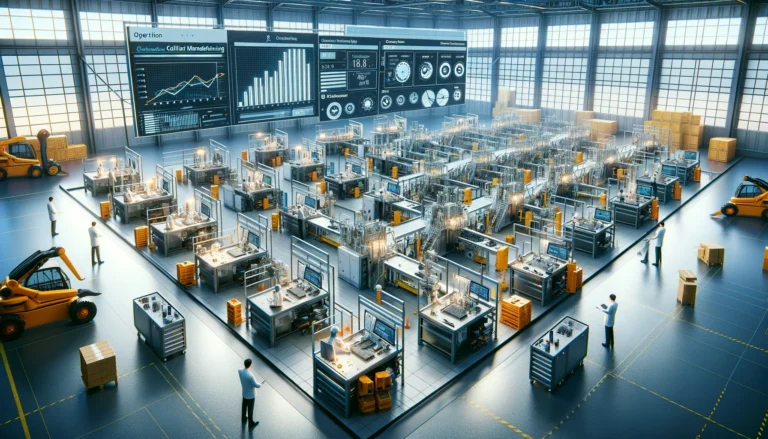- A set of tasks are prescribed to one group of people (cells) and they are responsible for one part of the production process.
- Complete units of work are then passed on to another group of people in the production process.
Advantages
- Allowsforsocialconnectionwithin groups and helps to motivate employees.
- People have some degree of job rotation, which multi skills employees.
- Absenteeism is not as big of a problem since the other group members are multi skilled and can complete their job too.
Disadvantages
- Completing the same job can be boring.
- You aren’t able to see the finished item, which may affect motivation.
- Teams are reliant on other groups to make sure final production targets are met.
Cellular manufacturing is a production approach derived from the principles of lean manufacturing, aimed at enhancing efficiency and flexibility by organizing the production floor into a series of cells. Each cell is designed to produce a specific group of similar products or components, optimizing the production process by minimizing waste, reducing setup times, and fostering a more skilled and versatile workforce. This approach stands in contrast to traditional mass production methods, where the production line is organized by function, leading to potential inefficiencies and higher costs associated with large inventories and extended setup times.
Core Principles of Cellular Manufacturing
Cellular manufacturing is built around several core principles that collectively aim to streamline the production process:
- Group Technology: This involves grouping parts or products with similar manufacturing processes into families, allowing them to be produced within the same cell, reducing setup times and inventories.
- Work Cell Design: Production cells are typically U-shaped, allowing for a smooth flow of materials and communication among workers, leading to improved efficiency and flexibility.
- Cross-trained Workers: Employees within a cell are trained to perform multiple tasks, enhancing flexibility and teamwork while reducing downtime and bottlenecks.
- Continuous Improvement: Embracing the lean manufacturing principle of Kaizen, cellular manufacturing encourages ongoing efforts to improve processes, reduce waste, and eliminate inefficiencies.
Advantages of Cellular Manufacturing
The cellular approach offers several advantages over traditional manufacturing methods:
- Reduced Setup Times: By grouping similar processes, setup times are significantly reduced, allowing for quicker response times to changes in production demands.
- Increased Productivity: The streamlined workflow and reduced movement of materials and workers lead to higher productivity levels.
- Improved Quality: With workers responsible for a broader range of tasks within a cell, there is a greater emphasis on quality control and accountability.
- Lower Inventory Levels: The efficient flow of materials and just-in-time production principles result in lower inventory levels and associated costs.
- Enhanced Flexibility: The ability to quickly adapt to changes in product design or demand is greatly improved, providing a competitive advantage in dynamic market conditions.
Challenges of Implementing Cellular Manufacturing
Despite its benefits, transitioning to cellular manufacturing can present challenges:
- Initial Setup Cost and Complexity: Designing and implementing production cells requires a significant upfront investment in planning, training, and possibly reconfiguring the production floor.
- Cultural Change: Shifting to a cellular approach often requires a cultural change within the organization, as workers and management adjust to new roles and responsibilities.
- Balancing Workloads: Ensuring that each cell is balanced in terms of workload and capacity can be challenging, particularly in environments with fluctuating demand.
Industry Example: Automotive Component Manufacturing
An illustrative example of cellular manufacturing can be found in the automotive component manufacturing industry. Companies such as Bosch or Denso have adopted cellular manufacturing to produce a wide range of components, from fuel injectors to electronic control units. In a typical scenario, a cell might be dedicated to assembling a specific type of fuel injector. The cell is equipped with all necessary tools and equipment, and the team within the cell is trained to perform all tasks related to the assembly and testing of that injector.
This arrangement allows for rapid adjustments to production volumes based on customer demand, with minimal downtime for setup changes. It also facilitates strict quality control measures, as the team within the cell takes full ownership of the production process from start to finish. The result is a highly efficient, flexible production system that can quickly respond to the needs of automotive manufacturers, ensuring timely delivery of high-quality components.
Conclusion
Cellular manufacturing represents a paradigm shift in production strategy, emphasizing efficiency, quality, and flexibility. By organizing the production floor into dedicated cells, companies can significantly reduce waste and setup times, improve product quality, and respond more dynamically to market demands. While the transition to a cellular setup can be challenging, the long-term benefits in terms of productivity and competitiveness are substantial. As demonstrated in the automotive component manufacturing industry, adopting cellular manufacturing can lead to significant operational improvements, making it an increasingly popular choice for companies striving to embrace lean manufacturing principles.
Frequently Asked Questions about Cellular Manufacturing in Business
- **Reduced Lead Times:** Parts move through the process faster.
- **Reduced Work-in-Progress Inventory:** Less accumulation of parts waiting for the next step.
- **Improved Quality:** Easier to spot and fix defects within the cell.
- **Increased Flexibility:** Can handle variations in product mix more easily than pure flow production.
- **Improved Employee Morale:** Workers feel more ownership over the complete process within the cell.
- **Reduced Material Handling Costs:** Parts travel shorter distances.





